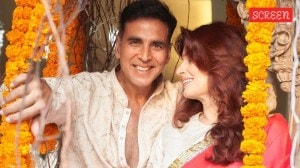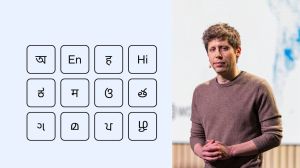The anti-EVM campaign
After the 2009 Lok Sabha polls,what began as scattered voices against the trust-worthiness of EVMs,began to acquire the shape of an organised campaign. Vandita Mishra looks at how the campaign has been playing out and the players involved.
When the Congresss CP Joshi lost the 2008 Rajasthan assembly elections by just one vote,he requested the Election Commission for a recount of the postal ballots. After the recount,a single vote still hung between Joshi and victory. Joshi accepted the verdict and called up EC officials,recalls chief election commissioner S Y Quraishi,to congratulate them for the conduct of the polls.
As the anti-EVM campaign draws public attention in the wake of the arrest and release on bail of Hari K Prasad,managing director of NetIndia,a Hyderabad-based research and development firm,who demonstrated the alleged tamperability of EVMs on a stolen machine earlier this year on TV,the real unease is not about what is being said out loud. It has to do with the breach of a line that has not been crossed in India. Yet.
The campaign has stopped short of questioning the outcome of any election. Their claim,campaigners insist,is not that elections have actually been manipulated in India,but that they are manipulable. Yet,at the same time,they frame the issue in apocalyptic termskey campaigner and psephologist GVL Narasimha Raos recently published book is titled Democracy at Risk! and a New Jersey-based NGO associated with the campaign calls itself Save Indian Democracy.
That the losers,even bad losers,accept the electoral outcome has been a routine and therefore unspectacular feature of Indias electoral and political system. There have been allegations of rigging,especially in the time of paper ballots,in particular constituencies,as in Meham in Haryana 1990; and individual losers across parties have petitioned the courts. But there is only the rare instance of a major party refusing to accept the overall outcome. In Assam 1983,the All Assam Students Union raised the foreigners issue to challenge the result after an election of very low turnout and high level of violence. In West Bengal 1972,the CPM alleged that polls were fraudulent; in Punjab 1992,the Opposition boycotted elections; and in J&K 1987,the Muslim United Front alleged mass rigging.
The ECs credibility has grown over the years. Especially after T N Seshan awakened the once sleepy institution to its own constitutional powers in the early 1990s,it has consistently ranked among Indias Most Trusted.
In the case of EVMs,at least two expert committees and a series of court verdicts have endorsed their use. The expert committee for the technical evaluation of the EVM set up by the Department of Electronics at the instance of the electoral reforms committee in 1990 unanimously certified that the system is tamper-proof in the intended environment. In 2006,the report of the expert committee for the technical evaluation of the upgraded EVM,constituted by the EC and headed by Prof P V Indiresan,concluded that the basic electronic voting machine developed by M/s. Bharat Electronics Limited (BEL) and M/s. Electronics Corporation of India Limited (ECIL) is a secure system.
In the AIADMK vs CEC of India and Others case in April 2001,the Madras High Court held that there is also no question of introducing any virus or bugs for the reason that the EVMs cannot be compared to personal computers the programme in EVM is entirely a different system. When the AIADMK went to the Supreme Court,it dismissed the special leave petition. The Karnataka HCs decision in the Michael Fernandes vs C K Jaffer Sharif case,February 2004,hailed the EVM as a symbol of national pride. The Bombay HCs decision in the Banwari Lal Purohit vs Vilas Muttemwar election petition in October 2005 also upheld their use. The Kerala HC did the same in the TA Ahammed Kabeer vs AA Azeez and Others case in February 2002; the Supreme Court upheld the decision in April 2003.
lll
Something changed around the time of the 2009 Lok Sabha polls,or more precisely after them. What had been a scattered and sporadic questioning began to acquire the shape and thrust of an organised campaign. What is more,the campaign lobbied for political support and found it in the losers of that election.
For psephologist GVL Narasimha Rao,the Delhi face of the campaign that appears to have taken off from Hyderabad and now finds echoes in pockets of faraway US,the trigger lay closer home. In 2004,all polls,not just mine,went haywire. We thought there was a problem with our methods and looked inwards. In 2009,again the polls were wide off the mark. As a pollster,I then looked at external factors.
About the same time in Hyderabad,V V Rao,a pharmacist who is also in the real estate business,and who describes himself as a social activist for the last 12 years,claims to have developed doubts of his own. Rao had worked as convenor with Election Watch for the 2009 LS and assembly polls in Andhra Pradesh. After the elections were over,he did a survey of EVM-related complaints and filed a PIL in the Supreme Court on July 9,2009. Along the way,he had drafted the technological expertise of Hari Prasad. After the apex court directed Rao and his team to approach the EC with their EVM doubts,the two sides have been meeting,inconclusively.
He was working on the technical,legal and political fronts,says V V Rao,and he approached Narasimha Rao to work Delhis political corridors. The latter,special invitee to the BJPs national executive last year and currently media adviser to the chief minister in BJP-ruled Madhya Pradesh,made the fit. The foreword of his 2010 book,billed as a shocking expose of the Election Commissions failure to assure the integrity of Indias electronic voting system,is written by LK Advani.
The campaign needed a forum,and VeTAcitizens for verifiability,transparency and accountability in electionswas born. International expertise was brought in through Satya Dosapati,an IIT alumni from Andhra Pradesh who runs the New Jersey-based Save Indian Democracy.
J Alex Halderman,professor of computer science at the University of Michigan,with a PhD from Princeton,who says his research spans applied computer security and tech-centric public policy issues,and Rop Gonggrijp,a technology activist from the Netherlands,were roped in. Responding to a questionnaire on e-mail,Halderman recalled how last winter,Dosapati invited him and Gonggrijp for a series of public events related to EVMs. It was then that we met Hari Prasad and immediately accepted his invitation to join the research effort.
On April 28 this year,a TV channel in Andhra Pradesh aired a video recording in which Halderman,Gonggrijp and Prasad claimed to have demonstrated the tamperability of a real EVM. Arrested for possession of the stolen EVM and now out on bail,Prasad claims to be the whistleblower the system did not protect. I am for EVMs,but they must be tamperproof ,he says.
Also in April,the campaign enlisted the support of 13 political partiesAIADMK,AIFB,AGP,CPI,CPI(M),INLD,JD(U),JD(S),RLD,RJD,RSP,SP,and TDP. They signed on a petition that said the EVM-related concerns are of national importance and called on the EC to hold an all-party meeting to discuss the urgent steps required to reform the voting system. While the monsoon session of Parliament was on,Chandrababu Naidu flew down from Hyderabad to hold a press conference in Delhi in which he called Prasads arrest unfortunate and reiterated the demand for an all-party meeting on EVMs. The same call was made inside the House the next day by Opposition parties,including the CPI(M) and BJP.
lll
Arguments for and against the Indian EVM centre on the technology of the machine and security procedures surrounding it. The EC points out that the technology is different from that used by countries where electronic voting has been discontinued,like Germany,the Netherlands and Ireland. That,combined with a unique set of administrative procedures,ensures the integrity of the Indian EVM.
According to deputy election commissioner Alok Shukla,India uses a standalone EVM with a one-time programmable chip; it does not have an operating system. From the time the software is made by BEL and ECIL till the time it is written on the chip by two companies in the US and Japan,random checks ensure the integrity and secrecy of the code is maintained.
These random checks are institutionalised throughout the EVMs life-cycle. Further,the randomised distribution of machines ensures that it is almost impossible to know till the last minute which machine goes to which polling booth in which constituency.
On EVMs,there is no definitive academic consensus There were some countries that banned them after the Florida recount in 2000,but others like Brazil have started using them since then, says Jorge Heine,professor of political science at Wilfrid Laurier University and distinguished fellow at the Centre for International Governance Innovation in Waterloo,Ontario. Prof Heine chaired a panel on EVMs at the 20th World Congress of Political Science at Fukuoka.
But eventually,the debate may not be technical or procedural. It (the anti-EVM campaign) is a classic case of misplaced priorities in thinking about and campaigning for political reform, says Yogendra Yadav,senior fellow at CSDS,Delhi,and a psephologist. A deep sense of political frustration informs our attempts at political reform. We are avoiding the weighty but mundane questions that are not prone to switch-on and switch-off solutions, he says.
We will soon call an all-party meeting to discuss EVMs
In his first interview after the EVM controversy broke out,CEC S Y Quraishi says Indias EVMs have stood the test of time
Thirteen political parties have written to the EC asking for an all-party meeting to discuss the EVM issue. What is the ECs response?
First we received a request from the BJP for an all-party meeting,and then a joint letter from 13 political parties. An all-party meeting is a serious matter. We are preparing a presentation for them so that we can discuss several issues together. Soon we will call a meeting.
The campaigners against the use of Indian EVMs cite examples of Ireland,Germany and the Netherlands. The German constitutional court has ruled against EVMs.
We should realise that in India,we follow the Supreme Court of India,not the Supreme Court of Germany. Also,we need to shed the colonial mindsetthat if something hasnt worked in countries of Europe,it will not work for us either. Our machines have been designed differently,they have stood the test of time and judicial scrutiny.
Do you see the campaign against EVMs taking a new turn after the 2009 LS polls?
This is not the first time that the use of EVMs has been challenged. But this time,it is more orchestrated and organised.
Do you have a larger worry about this campaign?
The larger worry is that it may undermine the peoples confidence. People have an abiding trust and faith in the EC and the electoral system. It has never been betrayed and in fact it has only been strengthened with every election. The campaigners are doing a disservice to Indian democracy.
How has the EVM changed the way elections are held in India?
The 2009 elections were hailed as one of the best by world leaders. EVMs have made elections more orderly,invalid votes are now history. Disputes and violence over voting are now behind us. Delay and demand for recount has gone down.
What would the EC say to those who insist that they are asking for improving the system,not uprooting it?
We at the EC are always improving the system in both its technical aspects and administrative procedures. The machine that was first used in 1982 has undergone changes,mostly suo moto. As far as the campaigners are concerned,the Commission has been meeting them. In our last meeting on August 10,I reiterated that the Commission is open to all suggestions. I even suggested that we fix the date for our next meeting.



- 01
- 02
- 03
- 04
- 05




























